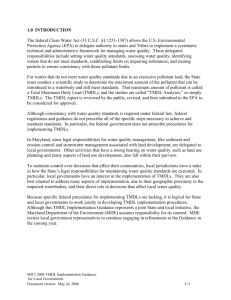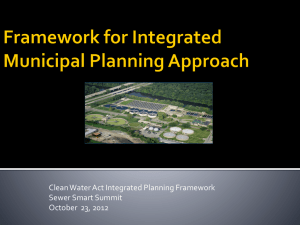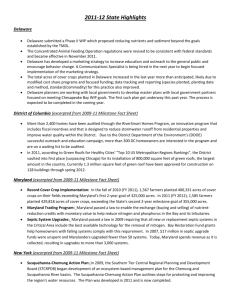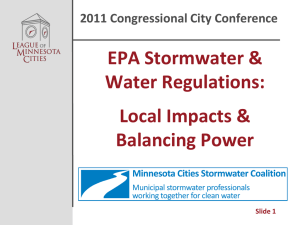Introduction
advertisement
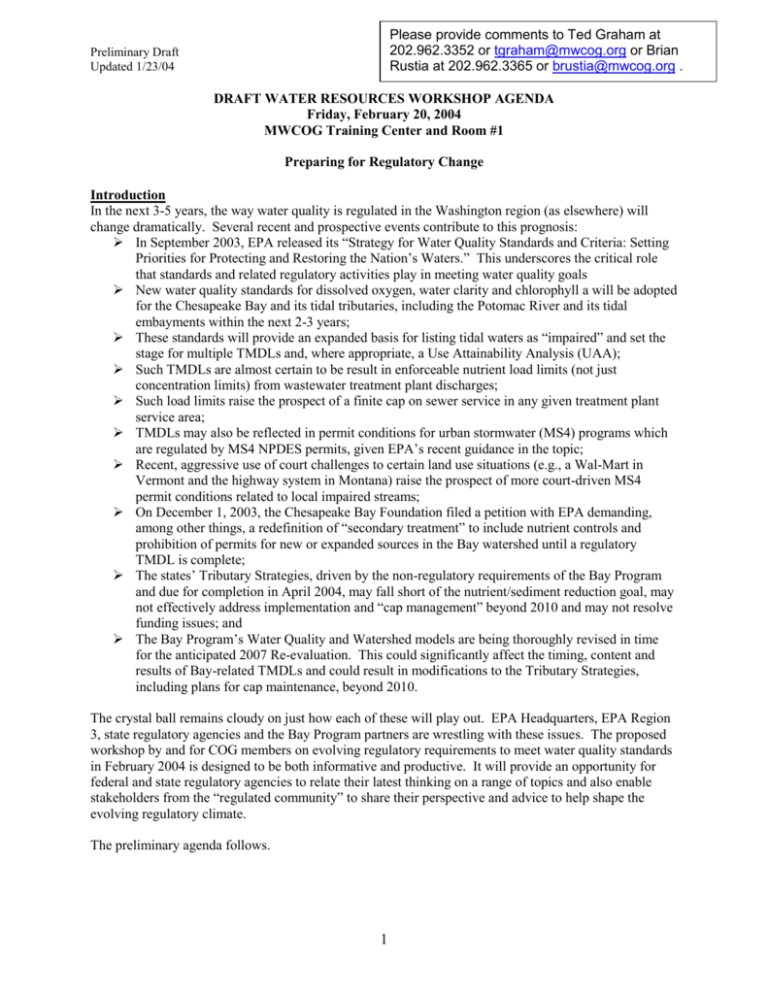
Please provide comments to Ted Graham at 202.962.3352 or tgraham@mwcog.org or Brian Rustia at 202.962.3365 or brustia@mwcog.org . Preliminary Draft Updated 1/23/04 DRAFT WATER RESOURCES WORKSHOP AGENDA Friday, February 20, 2004 MWCOG Training Center and Room #1 Preparing for Regulatory Change Introduction In the next 3-5 years, the way water quality is regulated in the Washington region (as elsewhere) will change dramatically. Several recent and prospective events contribute to this prognosis: In September 2003, EPA released its “Strategy for Water Quality Standards and Criteria: Setting Priorities for Protecting and Restoring the Nation’s Waters.” This underscores the critical role that standards and related regulatory activities play in meeting water quality goals New water quality standards for dissolved oxygen, water clarity and chlorophyll a will be adopted for the Chesapeake Bay and its tidal tributaries, including the Potomac River and its tidal embayments within the next 2-3 years; These standards will provide an expanded basis for listing tidal waters as “impaired” and set the stage for multiple TMDLs and, where appropriate, a Use Attainability Analysis (UAA); Such TMDLs are almost certain to be result in enforceable nutrient load limits (not just concentration limits) from wastewater treatment plant discharges; Such load limits raise the prospect of a finite cap on sewer service in any given treatment plant service area; TMDLs may also be reflected in permit conditions for urban stormwater (MS4) programs which are regulated by MS4 NPDES permits, given EPA’s recent guidance in the topic; Recent, aggressive use of court challenges to certain land use situations (e.g., a Wal-Mart in Vermont and the highway system in Montana) raise the prospect of more court-driven MS4 permit conditions related to local impaired streams; On December 1, 2003, the Chesapeake Bay Foundation filed a petition with EPA demanding, among other things, a redefinition of “secondary treatment” to include nutrient controls and prohibition of permits for new or expanded sources in the Bay watershed until a regulatory TMDL is complete; The states’ Tributary Strategies, driven by the non-regulatory requirements of the Bay Program and due for completion in April 2004, may fall short of the nutrient/sediment reduction goal, may not effectively address implementation and “cap management” beyond 2010 and may not resolve funding issues; and The Bay Program’s Water Quality and Watershed models are being thoroughly revised in time for the anticipated 2007 Re-evaluation. This could significantly affect the timing, content and results of Bay-related TMDLs and could result in modifications to the Tributary Strategies, including plans for cap maintenance, beyond 2010. The crystal ball remains cloudy on just how each of these will play out. EPA Headquarters, EPA Region 3, state regulatory agencies and the Bay Program partners are wrestling with these issues. The proposed workshop by and for COG members on evolving regulatory requirements to meet water quality standards in February 2004 is designed to be both informative and productive. It will provide an opportunity for federal and state regulatory agencies to relate their latest thinking on a range of topics and also enable stakeholders from the “regulated community” to share their perspective and advice to help shape the evolving regulatory climate. The preliminary agenda follows. 1 Preliminary Draft Updated 1/23/04 Preliminary Agenda MWCOG, Friday, February 20, 2004 8:30 – 9:30 Registration 9:30 – 9:40 Welcome and Overview: Peter Shapiro, Chair, COG’s Chesapeake Bay Policy Committee 9:40-10:10 Keynote Speaker: Paul Freedman, President, Limno Tech, Incorporated Mr. Freedman will provide an overview of emerging regulatory trends and challenge the participants on how best to be prepared and to get involved. 10:10-10:40 The View from Headquarters: Don Brady, Chief, Watershed Branch, US EPA Mr. Brady from EPA Headquarters will provide an overview of evolving regulatory issues from headquarters’ perspective. Topics will include: Listing guidelines; The prospects for a new TMDL rule; The connection between TMDLs and wastewater permits; and The connection between TMDLs and MS4 permits. 10:40-11:40 Panel #1 – Standards, Use Attainability, Impairments and TMDLs in the Washington Region (Regulatory Agency Representatives) Representatives from the Virginia Department of Environmental Quality (DEQ), the Maryland Department of the Environment (MDE) and the District of Columbia Department of Health (DC DOH) will provide an overview of their respective jurisdictions stand regarding adoption of new standards, expected implications for the list of impaired waters and schedules for TMDLs. The panel members are: DC-DOH – Jim Collier VA-DEQ – Al Pollock MDE – Rich Eskin 11:40-11:50 Break to Get Box Lunches (Provided) & Return to Training Center 11:50-12:30 Lunch & Lunchtime Speaker: Paul Calamita, Partner, AquaLaw The lunchtime speaker will cover issues of general interest with a regulatory theme drawing from a national perspective. The talk may provide commentary on recent examples of: use attainability, TMDL implementation via permits, successful delisting, interstate TMDL implementation, regulatory lawsuits and court decisions, etc. 12:45-1:00 Break to arrange breakout rooms After the break, there will be two tracks on (1) wastewater and (2) urban stormwater. One group will stay in the Training Center; the other will move to Room 1. Track 1 - Wastewater 1:00-1:45 Panel #2 – Wastewater Regulation Regulatory agency representatives from EPA Region 3; MDE and VADEQ will describe how they anticipate regulatory changes will affect wastewater dischargers. The panel members are: EPA Region 3 – Bob Koroncai MDE – TBD 2 Preliminary Draft Updated 1/23/04 1:45-2: 45 VA-DEQ – Al Pollock Panel #3 – Stakeholder Panel and Facilitated Discussion Part 1: Representatives from wastewater utilities and a representative from the Chesapeake Bay Foundation will describe their view on how new regulatory requirements should be implemented in relation to wastewater utilities. The panel members are: WSSC – Cy Jones DC-WASA – Mike Marcotte Alexandria Sanitation Authority – Glenn Harvey Chesapeake Bay Foundation – Theresa Pierno Part 2: With both Panels #2 & #3 present, Tanya Spano of the COG staff will facilitate a discussion so that the perspectives and questions of the audience can be fully aired. These will comprise much of the workshop summary Track 2 – Urban Stormwater 1:00-1:45 Panel #4 – Stormwater (MS4) Regulation Regulatory agency representatives from EPA Region 3; MDE and VADEQ will describe how they anticipate regulatory changes will affect MS4 stormwater permittees. The panel members are: EPA Region 3 – Paula Estornell MDE – Ken Pensyl VA-DEQ – Tom Faha 1:45-2:45 Panel #5 – Stakeholder Panel and Facilitated Discussion Part 1: Representatives from MS4 regulated agencies and the Natural Resources Defense Council (NRDC) will describe their view on how new regulatory requirements should be implemented in relation to MS4 permittees. The members are: Montgomery County, MD – Cameron Wiegand DC-WASA – Mohsin Siddique Northern Virginia Stormwater – Norm Goulet, NVRC Natural Resources Defense Council – Nancy Stoner Part 2: With both Panels #4 & #5 present, Brian Rustia of the COG staff will facilitate a discussion so that the perspectives and questions of the audience can be fully aired. These will comprise much of the workshop summary 2:45 Adjourn The workshop summary will be sent to all participants. 3
